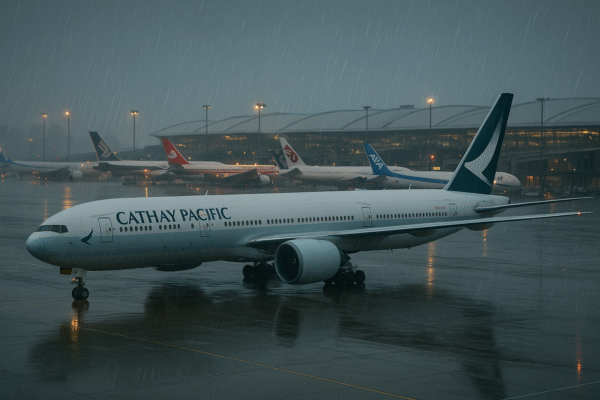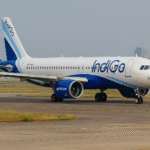A powerful storm system has triggered widespread flight disruptions across East and Southeast Asia, grounding over 600 flights and causing extensive delays at some of the region’s busiest airports. Major aviation hubs including Hong Kong International Airport (HKG), Singapore Changi Airport (SIN), and Beijing Capital International Airport (PEK) are struggling to restore operations as thunderstorms and heavy rain continue to batter the region.
According to updated data compiled from regional aviation authorities and airport operations reports, Hong Kong bore the brunt of the chaos. Over the past four days, more than 1,100 flights were canceled and 1,500 delayed, disrupting regional and international travel. Cathay Pacific, the city’s flagship carrier, has canceled more than 245 flights due to the severe conditions, affecting its network across Bangkok, Tokyo, and Singapore.
Disruptions by the Numbers
Flight Cancellation Totals (Cumulative):
- Hong Kong (HKG): 541 flights canceled
- Beijing Capital (PEK): 82 flights canceled
- Bangkok Suvarnabhumi (BKK): 70 flights canceled
- Singapore Changi (SIN): 39 flights canceled
- Guangzhou Baiyun (CAN): 46 flights canceled
- Delhi IGI (DEL): 18 flights canceled
- Shanghai Pudong (PVG): 21 flights canceled
- Kuala Lumpur (KUL): 31 flights canceled
- Tokyo Haneda (HND): 32 flights canceled
- Taipei Taoyuan (TPE): 8 flights canceled
Major airlines impacted include Cathay Pacific, Singapore Airlines, Air China, Korean Air, AirAsia, Air India, and All Nippon Airways (ANA), with some carriers reporting over 30 route suspensions each.
Hong Kong: The Epicenter of Chaos
At Hong Kong International Airport, delays reached a peak on Saturday with 441 postponed flights and 294 cancellations. While operations have marginally stabilized, Tuesday still saw 200 delays and 120 cancellations. The Airport Authority Hong Kong (AAHK) warned travelers to expect continued instability due to residual weather effects from the southern typhoon belt.
Changi Airport, Singapore: Cautious Recovery
Singapore’s Changi Airport, a major transit hub for Southeast Asia, also suffered heavily. Saturday marked the worst day, with 500 delays and 300 cancellations. While Tuesday saw reduced figures—250 delays and 100 cancellations—the four-day wave strained both regional and international flight schedules.
Changi Airport Group encouraged passengers to monitor flight updates via the Changi Airport app and stay in contact with airlines for rebooking options.
Japan, South Korea, and India Also Hit
In Tokyo, Narita International Airport reported 400 delays and 250 cancellations on Saturday alone. Airlines like ANA and Japan Airlines faced cascading operational issues through Tuesday. Similarly, Seoul’s Incheon Airport saw Saturday’s peak with 350 delays and 200 cancellations, with gradual improvement since.
In India, Delhi’s Indira Gandhi International Airport faced significant impact with 350 delays and 200 cancellations on Saturday. Mumbai also struggled with 280 delays and 150 cancellations at its peak. The Airports Authority of India has advised passengers to check their airline’s live schedules and arrive earlier than usual to navigate longer check-in times caused by backlog.
Southeast Asia: Bangkok, Kuala Lumpur, Jakarta
Bangkok Suvarnabhumi Airport recorded 420 delays and 250 cancellations on Saturday. Malaysia’s Kuala Lumpur International Airport saw similar figures. Both Jakarta’s Soekarno-Hatta International and Manila’s Ninoy Aquino Airport were affected as the storm moved southward.
Local meteorological departments, including the ASEAN Specialized Meteorological Centre, issued severe weather alerts through the weekend, citing intense low-pressure systems and monsoon surges.
Flight Operations Impact: Airlines Struggle to Respond
Cathay Pacific remained the most severely affected airline. According to their advisory, most canceled flights involved regional routes through Southeast Asia. Rebooking options were limited as multiple sectors were suspended simultaneously.
AirAsia, operating low-cost routes across Malaysia, Thailand, and the Philippines, grounded over 30 flights due to storm bands impacting Kuala Lumpur and Manila. Meanwhile, Air India faced route suspensions in both Delhi and Singapore sectors.
Many carriers have issued travel waivers, allowing free changes for affected itineraries. However, passengers have faced challenges finding alternative flights due to widespread seat shortages.
What Travelers Should Do
- Check flight status regularly via airline apps or official airport websites
- Arrive early due to backlog at security and check-in
- Rebook online where possible to avoid long queues at service desks
- Follow local weather warnings, especially in Southeast and East Asia
Outlook: Some Relief, But Uncertainty Remains
While conditions are gradually improving, weather forecasts by the Hong Kong Observatory and Japan Meteorological Agency suggest lingering instability over coastal regions. Airlines and airports may continue to experience delays, especially during peak hours.
The recent storm underscores Asia’s vulnerability to weather-driven aviation crises, especially during typhoon and monsoon seasons. For passengers and airlines alike, the disruption is a sharp reminder of the importance of contingency planning, real-time communication, and climate-resilient infrastructure.
For more travel news like this, keep reading Global Travel Wire


















